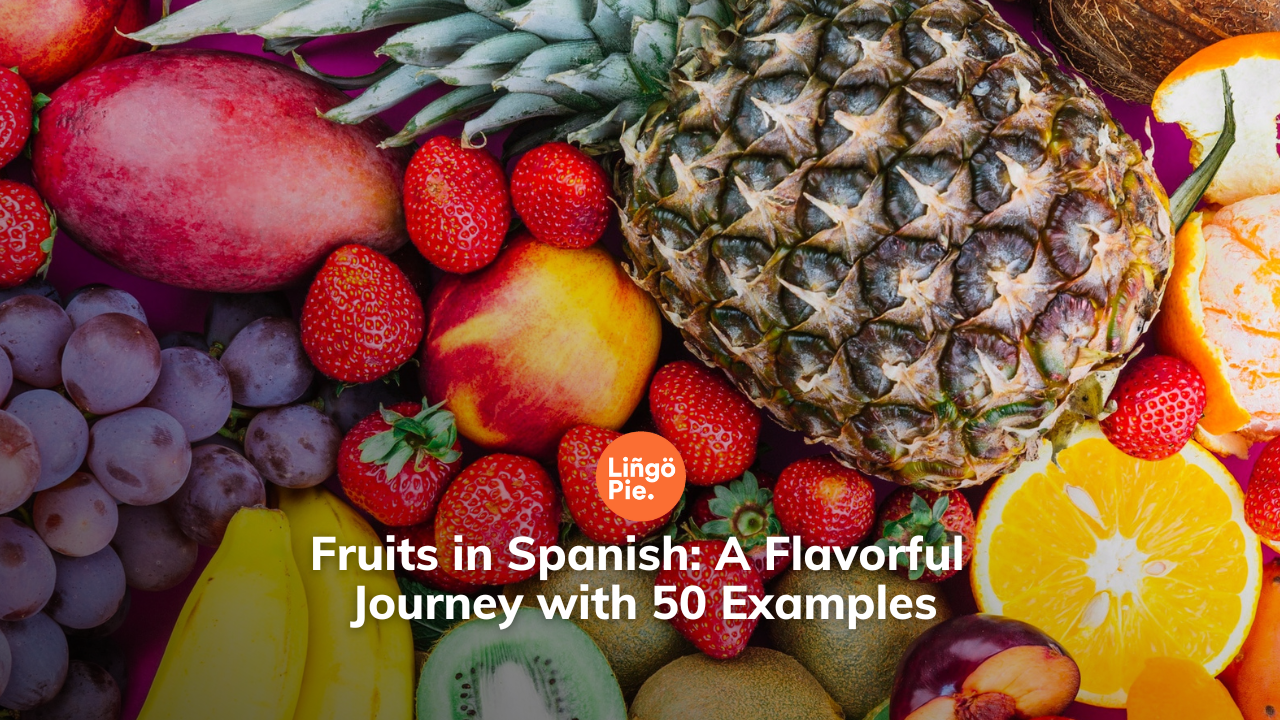The world of fruits is as diverse as it is delicious, particularly when we explore this richness in a language as vibrant as Spanish. From tropical fruits to more traditional varieties, each carries its own unique story, flavor, and texture. For English-speaking learners aiming to dive into Learning Spanish, understanding and talking about fruits can be a delightful way to enhance vocabulary and connect with Spanish-speaking cultures.

Here are 50 examples of fruits in Spanish that will take you on a flavorful journey:
- Apple - Manzana
- Banana - Plátano/Banana
- Orange - Naranja
- Pear - Pera
- Grape - Uva
- Watermelon - Sandía
- Pineapple - Piña
- Strawberry - Fresa
- Lemon - Limón
- Peach - Durazno/Melocotón
- Cherry - Cereza
- Mango - Mango
- Papaya - Papaya
- Coconut - Coco
- Avocado - Aguacate
- Kiwi - Kiwi
- Plum - Ciruela
- Pomegranate - Granada
- Lime - Lima
- Blueberry - Arándano
- Raspberry - Frambuesa
- Blackberry - Mora
- Melon - Melón
- Fig - Higo
- Passion Fruit - Maracuyá
- Guava - Guayaba
- Tangerine - Mandarina
- Apricot - Albaricoque
- Persimmon - Caqui
- Dragon Fruit - Pitahaya
- Star Fruit - Carambola
- Lychee - Lichi
- Grapefruit - Pomelo/Toronja
- Quince - Membrillo
- Cherimoya - Chirimoya
- Kumquat - Kumquat/Quinoto
- Prickly Pear - Tuna
- Jackfruit - Jaca
- Sapote - Sapote
- Soursop - Guanábana
- Breadfruit - Fruta de Pan
- Date - Dátil
- Fig - Higo
- Loquat - Níspero
- Mamey - Mamey
- Mulberry - Mora
- Nectarine - Nectarina
- Papaw or Pawpaw - Papaya
- Plantain - Plátano
- Rambutan -
Learning these names not only expands your vocabulary but also enhances your ability to engage in conversations about food, preferences, and cultural practices related to cuisine.
Practical Phrases to Use in a Market:

When navigating a market or discussing the purchase and consumption of fruits in a Spanish-speaking environment, these phrases can prove to be incredibly useful. While the phrases are provided in English for understanding, they're also translated into Spanish to help you practice and use them in real-life scenarios.
- How much is this fruit? - ¿Cuánto cuesta esta fruta?
- Can I have a kilo of apples, please? - ¿Me da un kilo de manzanas, por favor?
- Are these bananas ripe? - ¿Están maduras estas bananas?
- I would like to buy some strawberries. - Quisiera comprar unas fresas.
- Do you have any organic fruit? - ¿Tiene fruta orgánica?
- I'm looking for local fruits. - Estoy buscando frutas locales.
- Can I taste the grapes before buying? - ¿Puedo probar las uvas antes de comprar?
- What's the freshest fruit you have today? - ¿Cuál es la fruta más fresca que tiene hoy?
- How should I store these avocados? - ¿Cómo debo almacenar estos aguacates?
- Can you recommend a sweet fruit? - ¿Puede recomendarme una fruta dulce?
- I need fruits for a salad; what do you suggest? - Necesito frutas para una ensalada; ¿qué sugiere?
- Which fruits are in season right now? - ¿Qué frutas están en temporada ahora?
- Could you give me a discount if I buy more? - ¿Podría darme un descuento si compro más?
- I prefer my fruit a bit underripe. - Prefiero mi fruta un poco verde.
- Do these peaches come from a local farm? - ¿Estos duraznos vienen de una granja local?
These phrases not only help with transactions but also enable you to engage more deeply with the local culture and practices surrounding food. Whether you're at a bustling market in Mexico or a quaint fruit stand in Spain, these sentences will surely make your fruit buying (and eating) experience smoother and more enjoyable.
Now, how can you effectively learn and remember all these fruits in Spanish? This is where Lingopie steps in.
Lingopie: Your Gateway to Learning Spanish Through Culture
Lingopie is an innovative app designed to teach Spanish through the immersive experience of TV shows and movies from Spanish-speaking countries. It's an engaging way to learn the language in context, including the names of fruits and much more. As you watch, you'll hear native speakers in various real-life situations, including shopping at markets, cooking at home, and dining out, where fruits are often the stars of the show.
Lingopie's unique feature of clickable subtitles allows you to click on any word, including the names of fruits, to see its translation and hear its pronunciation. This interactive learning tool helps you to not only learn vocabulary in a memorable way but also understand how these words fit into sentences and everyday conversation.
By integrating Lingopie into your language learning routine, you can enhance your Spanish comprehension skills while enjoying the rich, diverse cultures of the Spanish-speaking world. It's a deliciously effective way to learn, blending the joys of language and culinary discovery. Whether you're a beginner or looking to polish your Spanish, Lingopie offers a unique and flavorful path to fluency.






![30+ Modern English Slang Terms For Money [Guide]](/blog/content/images/size/w300/2025/06/Slang-term-for-money.jpg)
![5 Official Spanish Language Tests To Show Your Proficiency Level [Guide]](/blog/content/images/size/w300/2025/06/Spanish-Language-Tests.jpg)

![Why Memorizing Spanish Words Won’t Make You Fluent [Tips]](/blog/content/images/size/w300/2025/06/how-to-practice-spanish-vocabulary.jpg)